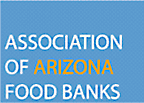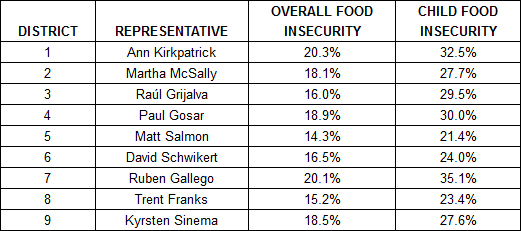 Phoenix AZ (April 14, 2015) – Feeding America released new Map the Meal Gap data today revealing almost 1 in 5 Arizonans (17.5%), or 1.16 million people, struggled with food insecurity in 2013 – essentially unchanged from the 17.8% figure from 2012. When a household suffers from food insecurity, it means they may at times lack access to or the ability to afford enough food to feed their household. The national food insecurity rate in 2013 was 15.8%.
Phoenix AZ (April 14, 2015) – Feeding America released new Map the Meal Gap data today revealing almost 1 in 5 Arizonans (17.5%), or 1.16 million people, struggled with food insecurity in 2013 – essentially unchanged from the 17.8% figure from 2012. When a household suffers from food insecurity, it means they may at times lack access to or the ability to afford enough food to feed their household. The national food insecurity rate in 2013 was 15.8%.
Arizona children didn’t make much progress either, with more than 1 in 4 (28.0% – an estimated 454,460) also suffered from food insecurity in 2013, compared to 28.2% the previous year. Research confirms children who do not get enough nutritious food each day perform poorly in school, have more behavioral issues and suffer from absenteeism far more often than children who are not food insecure.
“Daily, too many Arizona families continue to struggle to put food on their plates, something most of us take for granted,” said Angie Rodgers, AAFB president and CEO. “These numbers confirm what our food banks see every day. Demand remains high amidst a slow and incomplete economic recovery where too many are without enough work or wages to provide for their family’s basic needs.”
Map the Meal Gap also provides 2013 food insecurity estimates by county and congressional district. In Arizona, Apache County had the highest rate of food insecurity at 28.2%, while Greenlee County had the lowest rate at 14.4%. By comparison, Maricopa County had a 15.9% food insecurity rate, while Pima County was at 15.8%. Here again, children suffered more with every Arizona county having a child food insecurity rate of at least 24.8% (Greenlee County), with Apache County having a 43.0% rate. Maricopa County had a 25.4% food insecurity rate was 25.4%, while Pima County was at 26.1%. By Congressional district:

Map the Meal Gap is based on an analysis of statistics collected by the U.S. Department of Agriculture, U.S. Census Bureau, and the U.S. Bureau of Labor Statistics in 2013, the most recent year for which data is available. The study, commissioned by Feeding America, is a detailed analysis of the nation’s food insecurity.
The study is supported by the Founding Sponsor Howard G. Buffett Foundation as well as the ConAgra Foods Foundation and Nielsen. The food price data and analysis was provided by Nielsen (NYSE: NLSN), a global provider of information and insights. The lead researcher is Dr. Craig Gundersen, professor of Agricultural and Consumer Economics at the University of Illinois, executive director of the National Soybean Research Laboratory and member of Feeding America’s Technical Advisory Group.
The full Map the Meal Gap report, including an interactive map that allows viewers to explore the issue of food insecurity in Arizona and across the country, including by county and congressional district, can be found at www.feedingamerica.org/mapthegap.
Established in 1984, the Association of Arizona Food Banks is a private, non-profit organization serving five-member regional food banks (Community Food Bank of Southern Arizona, Desert Mission Food Bank, St. Mary’s Food Bank Alliance, United Food Bank, Yuma Community Food Bank) and a network of nearly 1,200 food pantries and agencies. AAFB is one of the first state associations in the nation and an inaugural partner state association of Feeding America. AAFB was instrumental in the development of a statewide gleaning project, and our advocacy efforts have brought about beneficial state and federal legislation for our member food banks and the people they serve. For more information, to find a food bank or pantry in your area, or to learn more about donation and volunteer opportunities, please visit www.azfoodbanks.org.





1 Comment
Hunger is now called ‘Food Insecurity’?
Say what?